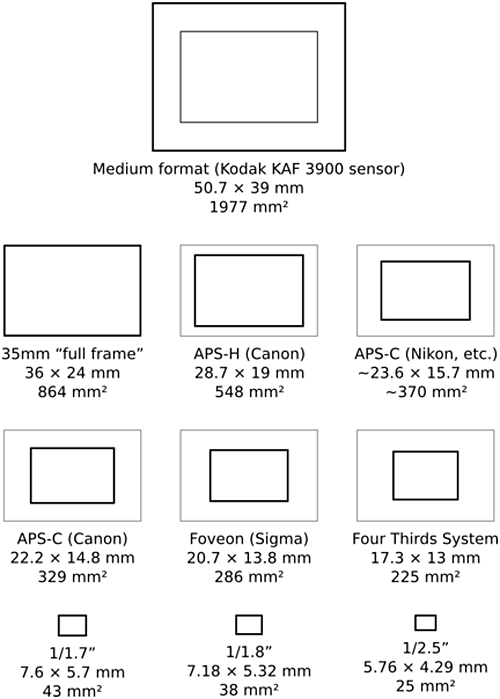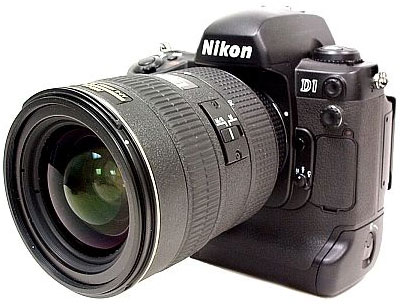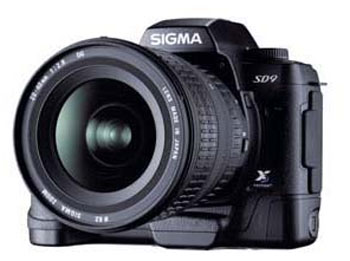The Digital Sensor: A Guide to Understanding Digital Cameras
by Wesley Fink on April 21, 2008 1:00 AM EST- Posted in
- Digital Camera
Sensor Size and Multipliers

Canon had become a dominant player in the SLR market after their successful launch of the EOS all-electronic mount for AF. Canon was also large enough with enough resources to develop and manufacture their own sensors. Canon launched a professional standard APS-H camera, with a 1.3X lens multiplier that used existing Canon 35mm lenses. Later, when Canon was ready to create a consumer digital SLR market they used a smaller 22.2x14.8mm sensor with an area of 328mm² and a lens multiplier of 1.6X. This is 38% the area of a full-frame sensor.
More recently, Canon has championed the full-frame sensor in their pro cameras and in their pro/amateur 5D model. Larger sensor manufacturing cost has dropped as digital sensors have evolved and it now appears likely the APS-H (1.3X lens multiplier) will eventually drop form the Canon line. Since no lenses depend on that image circle all current Canon full-frame lenses, such as those used with the APS-H cameras, will remain usable on the full-frame sensor pro models that will replace them.

Nikon, Pentax, and Minolta all had significant success in the 35mm film market, so all three had a vested interest in preserving their 35mm lens mount and keeping their current 35mm system users happy. However, none of these three had the resources to develop and manufacture their own sensors, so they partnered with sensor manufacturers to produce digital SLR cameras. In recent years that partner has been Sony, so all three manufacturers have basically adopted a larger 23.6x15.7mm sensor with a 1.5X lens multiplier.

Sony purchased the Photo Imaging division of Konica Minolta in 2006 and carried on the Minolta lens mount under the Sony brand. Today Sony both manufactures their own Sony brand cameras with Sony sensors and they continue to sell sensors to Nikon, Pentax, and Samsung.
Olympus was a huge player in the digital compact market as the market began its slow move to the digital SLR. While Olympus had been a very successful player in the film SLR market, they lost market in the SLR Auto-Focus wars kicked off by the success of the Minolta 7000. Olympus AF cameras remained a fringe product and Olympus eventually exited the market to concentrate on their compact digital offerings.

Olympus had a stake in the compact market remaining dominant and they had little legacy 35mm business to protect. Both developments made them late to the digital SLR market, but they made the best of it with a different approach than the other DSLR players. Olympus developed a new all-electronic DSLR lens mount and camera system based around a Kodak sensor with a 4:3 ratio instead of the 3:2 common in 35mm. With no legacy lenses to protect, the concept of lens multiplier is basically meaningless when talking about the Olympus DSLR system, but the diagonal is 1/2 the 35mm full-frame so lenses are equivalent to a 35mm lens at twice the focal length.
Olympus and its partners also made the 4/3 standard open - that is, it's available to any manufacturer. Currently Olympus, Panasonic, and Leica are producing 4/3 cameras and lenses but other manufacturers may join them in the future. Olympus is also now using sensors manufactured by Panasonic, a development partner, in their 4/3 cameras.

Sigma is best known as an independent lens manufacturer, but they have been producing SLR camera bodies for almost 30 years. Sigma introduced their first digital SLR with the SD9 in 2002. Sigma is the only DSLR manufacturer to use the unique Foveon sensor, which captures all three colors in a digital image in three layers - red, blue green - on a sensor. All other current digital sensors are based on Bayer sensors, which capture all three colors in mosaic patterns on a single sensor layer. Colors are then restored by an interpolation process called demosaicing, which theoretically converts the three color mosaics into smooth full-color images.
For this discussion, the current Sigma SD14 should be considered a niche DSLR player with very small market share. The Foveon sensor falls between 4/3 and the Canon 1.6 in size and has a 1.7X lens multiplier. Sigma is the only third party lens maker to produce lenses for all the camera systems discussed here. Some are full-frame designs with digital coatings to mount on full-frame or smaller digital sensor SLRs. Other designs are based on the largest 1.5X APS C image circle and are designed to work with smaller DSLR sensors ranging from 1.5X to 2X lens multiplier.










72 Comments
View All Comments
andrewln - Monday, April 21, 2008 - link
This was followed in about 6 months by the introduction of the Samsung 14.6MP CMOS sensor in the Pentax D20.should be Pentax K20D
Wesley Fink - Monday, April 21, 2008 - link
Typo corrected. Unfortunately spell check can't catch model numbers that are misstated.araczynski - Monday, April 21, 2008 - link
now i know what pc tech illiterate people feel like :)its a good thing i don't care about photography, interesting read none the less.
finbarqs - Monday, April 21, 2008 - link
the thing is, I've read the reviews and saw the comparisons between the 5D and the D200 (I believe that was the last CCD sensor that Nikon used). The 5D has way better per-pixel sharpness than the D200. Perhaps the technology of the CMOS made it so it finally "looks" better than the CCD. Or at least on the Canon side of things. I'm not biased towards any camera. I've own an XTi, 5D, Panasonic DMC-L1, and now a D300. I'm hoping to own the next 5D MKII (or whatever they call it).Even the D2X used a CMOS sensor, and I thought Nikon made the D300 sensor, as well as the D3 sensor (FF). What I also find "funny" is that Sony doesn't have a FF sensor yet, but nikon does, thus leaving me to believe that Nikon came up with their own FF sensor.
melgross - Monday, April 21, 2008 - link
It's Nikon's own design, though I don't remember who makes it.haplo602 - Monday, April 21, 2008 - link
Nice article Wesley, finaly one Anandtech photo related article I enjoyed reading.On note on the growing megapixel count. Sooner more than later, DSLR in APS-C (and later full frame ones) will hit the same technology wall P&S are facing (too small photosite).
This is one factor that makes me a happy film shooter :-) I know that my limit is the scanner up to around 10MP and I have less flexibility in shooting conditions (either 2 bodies or limited by ISO and film type), in every other situation I am equal or better off.
I am waiting for an affordable Nikon full frame body and then I will make my switch to digital (but that is yet years to come).
wally626 - Monday, April 21, 2008 - link
A sensor technology improves APS-C will be able to go to high enough pixel counts and have very good quality. For most consumers some where around 12 MP is enough, if the sensors improve to where this can hit 3200 ISO with low noise 99 percent of the market would be satisfied.The full frame bodies will replace the medium formats of the film world. There have been some really good medium format cameras that take much better images than 35mm but very few are sold. I think the article is correct in saying the full-frame DSLR will be the PRO cameras and priced as such.
melgross - Monday, April 21, 2008 - link
The number ofpixels is directly related to the print size.If you go by the oft quoted 300 dpi on the final print for maximum quality, you will need a sensor with 2400 x 3600 resolution for a full frame 8 x 12 print, or 8.64 MP. For an 8 x 10, it would be 7.2 MP (4/3 sensor).
For a larger 11 x 17, it would be 3300 x 5100, or 16.83 MP, or 13.86 for the 11 x 14 4/3 sensor print.
You can figure the rest of the sizes my multiplying the inch size of the print edges L x W by 300 to come up with a number.
But the truth is that 240 dpi is going to be good enough fot most prints, and youcan do the numbers that way.
When you know the numbers, you can figure out what size sensor you will need for the highest quality work.
But for most people, even 180 dpi will be enough for their prints. Going to that gives more flexibility, as the sensor pixel count is much smaller.
It's better to get a camera with a longer OPTICAL zoom rather than to go for the biggest number of sensor pixels.
haplo602 - Tuesday, April 22, 2008 - link
^ this ^It's all a matter of print size. I am an amateur/hobbyist, and anything past A4 is large for me. I have printed reasonable quality 8x12 prints from a consumer slide film and home film scanner.
I can hang them up on the wall in a nice frame and they will serve their purpose :-)
Idealy I'd need a 12-14MP full frame Nikon with goot ISO/Noise characteristics (f.e. D3) and it will satisfy my needs for years to come.
Heidfirst - Monday, April 21, 2008 - link
especially as I was wondering the other day what smaller process technology would do for digital sensors?Normally of course smaller process means cooler & more importantly smaller>cheaper to make but of course with sensors you are talking a fixed size so not any cheaper.
But would the potential increased precision of circuitry mean any better image quality?
& a little nitpicking:
Sony didn't buy Konica Minolta (which continues in business) but certain assets from the Photo Imaging division of KM. As to what that actually means there is little hard knowledge outside the 2 companies as it seems that KM still retain some IP & indeed a shareholding in some of the production facilities.
Also, current thinking seems to be that the "A900" may not be called that but something else to differentiate it from the APS-C models.